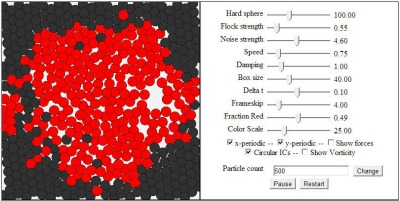Mosh Pits Teach Us About the Physics of Collective Behavior
Even willfully "random" crowd behavior is predictable.

Stop me if you've heard this one. A Cornell graduate physics student takes his girlfriend to her first heavy metal concert. Instead of diving straight into the mosh pit, as he typically would, he hangs back "to keep an eye on her."
Being a physicist first and a mosher second ("fieldwork was independently funded"), the student, Jesse Silverberg, can't help but notice curious patterns in what had always felt like the epitome of chaos. "Being on the outside for the first time, I was absolutely amazed at what I saw -- there were all sorts of collective behaviors emerging that I never would have noticed from the inside." So for an even better perspective, he turns to YouTube, to figure out what happens to people under the "extreme conditions" borne of a combination of "loud, fast music (130 dB, 350 beats per minute) ... bright, flashing lights, and frequent intoxication."
What he found, of course, was the "collective phenomenon consisting of 10^1 to 10^2 participants commonly referred to as a mosh pit." And he was able to prove his initial observation: While the individual movements of moshers may be random, their collective behavior follows a few simple rules.
He and his team then "simplif[ied] the complex behavioral dynamics of each human mosher to that of a simple soft-bodied particle," creating an interactive model for demonstrating their movement that, even if you're not clear on the physics, is fun to play with (try turning up the noise strength and watch what happens).
The red guys are active MASHers (that's "Mobile Active Simulated Humanoids"), identified as "self-propelled, experience flocking interactions...subject to random fluctuations in the forces they experience." The rest are just trying to enjoy the music:

Look familiar? Moshers, as they "move randomly, colliding with one another in an undirected fashion," seem a lot like gas particles, the researchers note. Or, as Silverberg explained to me: "It turns out that the statistical description we use for gasses matches the behavior of people in mosh pits. In other words, people bounce around like the molecules in a gas." And they can be understood using the same basic principles we use to study those molecules.
Using videos of heavy metal concerts, write the authors, allows them to study crowd behavior in a way that staged experiments haven't been able to. According to Silverberg, the unique circumstances (re: loud music and intoxication) of mosh pits are applicable to other instances of collective motion, like riots or emergency situations, where panicked crowds tend to break into random, slightly hysterical motion. Better understanding their dynamics might serve to improve safety measures in buildings or stadiums. If nothing else, they may serve as a useful reference to EMTs in the very pits where the research originated (per one study, 37 percent of injuries that took place over the course of a four-day music festival were "related to moshing activity").
But the study can also just be enjoyed for curiosity's sake. When something like the "wall of death" ("moshers split into two groups separated by an open space and, when signaled, simultaneously run at the opposing group") happens, we need someone to try and explain what's going on. And that's what scientists are here for, right?
"Incidentally," says Silverbeg, "my girlfriend hasn't been to another metal show since."